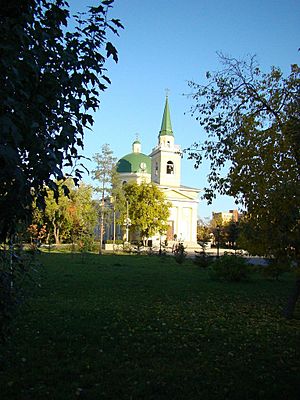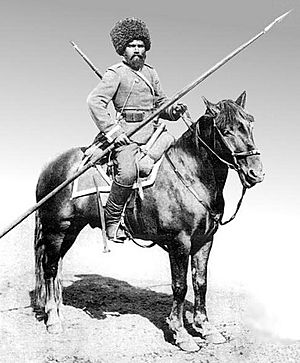Siberian Cossacks facts for kids
The Siberian Cossacks were a special group of Cossacks who made their homes in the Siberian part of Russia. They started settling there in the late 1500s. This happened after a famous explorer named Yermak Timofeyevich led the Russian conquest of Siberia. In the early days, many Russian people in Siberia, especially those who served the government, were called Cossacks. This was because they were not landowners or farmers. Most of these early settlers came from northwest Russia. They were not closely related to the well-known Don Cossacks or Zaporozhian Cossacks.
Contents
History of Siberian Cossacks
Serving the Tsars
Siberian Cossacks were important soldiers for the Russian rulers, called Tsars. They fought in many wars from the 1700s until the Russian Revolution in 1917. By 1801, the Siberian Cossack army, known as a Host, had 6,000 Cossacks. These soldiers guarded towns and borders in the region. A few years later, in 1808, their army was organized into ten groups of horse-riding Cossacks. They also had two groups with horse-pulled cannons.
During the Russo-Japanese War in 1905, Siberian Cossacks made up a large part of Russia's cavalry. Cavalry means soldiers who fight on horseback. However, some people thought their horse-riding skills were not the best. They were sometimes called "infantry on horseback". This meant they were more like foot soldiers who just used horses to get around.
After the Revolution
The Siberian Cossack Host was officially ended in 1919. This happened after the Russian Revolution. The new Soviet government tried to remove the special culture and traditions of all Cossacks. While some Cossack groups were started again in 1937, there were no specific Siberian Cossack units. Today, a group in the Russian army is called "Cossack". This group is located in Borzya in the Eastern Military District.
Cossack Uniforms and Look
In 1802, the Siberian Cossacks were allowed to wear special uniforms. Before this, they wore their own traditional clothes. At first, their uniforms looked like those of the Don Cossacks. But after 1812, they started wearing clothes more like a lancer's uniform. Lancers were soldiers who carried long spears called lances. Even with these rules, Siberian Cossacks often still used their own clothes and gear. This meant their uniforms looked different from person to person.
By the 1880s, the Siberian Cossacks had a special color: red. This red color was on their cap bands, shoulder straps, and wide stripes on their pants. Their main uniform was green and loose-fitting, like other Cossacks from the steppes. Sometimes, they wore tall furry hats with red cloth on top. In the early 1900s, officers had black collars and pointed cuffs with red edges. Their shoulder straps were silver. By 1909, regular soldiers received khaki jackets and caps from the government. But they still kept their red uniform parts and green pants.
The Siberian Cossacks were honored for their brave service in 1812. This was during the French invasion of Russia. Because of their bravery, their regiments were given a special privilege. They could attach colorful flags, called pennants, to their lances. Lances were their main weapon until World War I.
See also
 In Spanish: Cosacos de Siberia para niños
In Spanish: Cosacos de Siberia para niños



